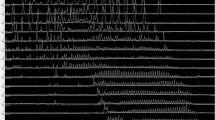Abstract
Previous studies have suggested a relationship between the presence of digital arches and the occurrence of early-onset chronic intestinal pseudoobstruction (CIP). We recently had under our care a patient who died of complications from neuropathic familial CIP (FCIP) and who had family members with symptoms and radiographic findings consistent with FCIP. Our aim was to determine if there is a relationship between FCIP and digital arches using members of this patient's family tree. Questionnaires, telephone follow-up, and clinical and radiographic evidence were all utilized to determine whether a diagnosis of CIP could be made for the family members of this deceased FCIP patient. Fingerprints were sought for all study subjects. Eight of the 26 study subjects who were fingerprinted had clinically diagnosed FCIP and four of these eight had radiographic confirmation. All eight were positive for one or more arches (sensitivity =100%). Only one of the 18 subjects without a diagnosis of FCIP who were fingerprinted had arches (specificity =94%). The likelihood of linkage between the presence of digital arches and FCIP in our study family was significant by genetic linkage analysis criteria. These results show a significant correlation between FCIP and digital arches (P <0.0001). Whether this relationship is a causal one, ie, the gene responsible for digital arches is also responsible for FCIP, or is the result of linkage between the genes for FCIP and digital arches remains unclear.
Similar content being viewed by others
References
Byrne WJ, Cipel L, Euler AR, Halpin TC, Ament ME: Chronic idiopathic intestinal pseudo-obstruction syndrome in children—clinical characteristics and prognosis. J Pediatr 90:585–589, 1977
Gauderer MW, Halpin TC Jr, Izant RJ Jr: Pathologic childhood aerophagia: A recognizable clinical entity. Journal of Pediatr Surg 16:301–305, 1981
Glassman M, Spivak W, Mininberg D, Madara J: Chronic idiopathic intestinal pseudoobstruction: A commonly misdiagnosed disease in infants and children. Pediatrics 83:603–608, 1989
Pineiro-Carrero VM, Andres JM, Davis RH, Mathias JR: Abnormal gastroduodenal motility in children and adolescents with recurrent functional abdominal pain. J Pediatr 113:820–825, 1988
Byrne WJ, Cipel L, Ament ME, Gyepes MT: Chronic idiopathic intestinal pseudoobstruction syndrome: Radiologic signs in children with emphasis on differentiation from mechanical obstruction. Diagn Imaging 50:294–304, 1981
Schuffler MD, Rohrmann CA Jr, Templeton FE: The radiologic manifestations of idiopathic intestinal pseudoobstruction. Am J Roentgenol 127:729–736, 1976
Gottlieb SH, Schuster MM: Dermatoglyphics (fingerprint) evidence for a congenital syndrome of early onset constipation and abdominal pain. Gastroenterology 91:428–432, 1986
Striano A, Andreotti MR, Perrotta V, Strisciuglio P: Prevalence of digital arches in children with abdominal pain and constipation. J Pediatr 117(3):435–436, 1990
Pulliam TJ, Schuster MM: Congenital markers for chronic intestinal pseudoobstruction. Am J Gastroenterol 90(6):922–926, 1995
Lathrop GM, Lalouel JM, Julier CC, Oh J: Strategies for multilocus linkage analysis in humans. Proc Natl Acad Sci USA 81:3443–3446, 1984
Hyman PE, Rudolph CD, Altschuler SM, Christensen J, Colletti RB, Cucchiara S, Di Lorenzo C, Flores AF, Hillenmeier AC, McCallum RW, Vanderhoof JA: Diagnosis and treatment of chronic intestinal pseudoobstruction syndrome in children: Report of consensus workshop. Janssen Pharmaceutical-sponsored consensus workshop, 1995
Anderson MW, Bonne-Tamir B, Carmelli D, Thompson EA: Linkage analysis and the inheritance of arches in a Habbanite isolate. Am J Hum Genet 31(5):620–629, 1979
Angrist M, Kauffman E, Slaugenhaupt SA, Matise TC, Puffenberger EG, Washington SS, Lipson A, Cass DT, Reyna T, Weeks DE: A gene for Hirschsprung disease (megacolon) in the pericentromeric region of human chromosome 10. Nature Genet 4(4):351–356, 1993
Angrist M, Weissenbach J, Garver KL, Ladda R: Identity-by-descent and association mapping of a recessive gene for Hirschsprung disease on human chromosome 13q22. Hum Mol Genet 3(8):1217–1225, 1994
Schaumann BA, Opitz JM: Clinical aspects of dermatoglyphics. Birth Defects: Orig Art Ser 27(2):193–228, 1991
Ziegler AG, Mathies R, Ziegelmayer G, Baumgartl HJ, Rodewald A, Chopra V, Standl E: Dermatoglyphics in type 1 diabetes mellitus. Dermatoglyphics 722–724, 1993
Author information
Authors and Affiliations
Rights and permissions
About this article
Cite this article
Chakravarti, A., Blanton, S., Kendall, B.J. et al. Cosegregation of familial intestinal pseudoobstruction and presence of digital arches in a large multigenerational pedigree. Digest Dis Sci 41, 1429–1433 (1996). https://doi.org/10.1007/BF02088569
Received:
Revised:
Accepted:
Issue Date:
DOI: https://doi.org/10.1007/BF02088569




